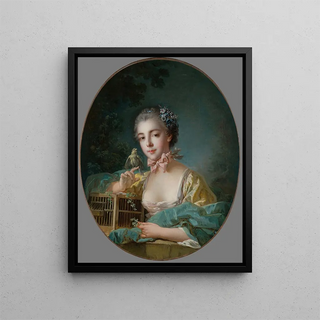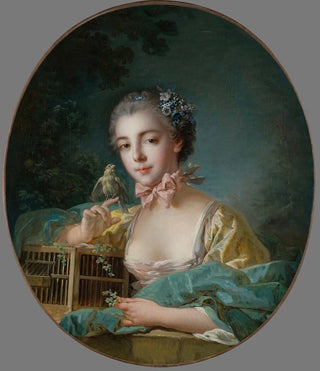Art print | Presumed portrait of Marie-Émilie Baudouin, daughter of the painter - François Boucher


View from behind

Frame (optional)
Portrait of Marie-Émilie Baudouin, daughter of the painter - François Boucher – Captivating Introduction
The "Portrait of Marie-Émilie Baudouin, daughter of the painter" is an iconic art print by François Boucher, an undisputed master of French rococo. This painting, both intimate and elegant, captures the very essence of an era where art intertwines with everyday life. The depiction of Marie-Émilie, the painter's daughter, evokes not only a familial bond but also a reflection on feminine beauty and delicate feelings. Every brushstroke seems to whisper secrets of a bygone time, inviting the viewer to immerse themselves in a universe filled with grace and refinement.
Style and uniqueness of the work
François Boucher's style is characterized by lightness and sensuality, which manifest in the choice of colors and the fluidity of forms. In this art print, the pastel palette and delicate shades of pink and blue create a soft, dreamlike atmosphere. The features of Marie-Émilie are rendered with remarkable finesse, highlighting the luminosity of her face and the sparkle in her eyes. The composition, meanwhile, demonstrates a harmonious balance between the subject and her environment, where drapery and ornaments add an extra dimension to the scene. This work, while a portrait, transcends simple representation to become a true ode to beauty and femininity.
The artist and his influence
François Boucher, born in 1703, was a painter whose influence endures beyond his era. Raised in the artistic circles of Paris, he captured the spirit of the 18th century, a period marked by a pronounced taste for exuberance and pleasure. His work is distinguished by technical skill and overflowing imagination, which allowed him to establish himself as one of the most prominent artists of his time. As a court painter, he also helped shape the image of the French monarchy through portraits and mythological scenes. His ability to combine the sublime with everyday life paved the way for new artistic currents, influencing many artists who followed him. The "Portrait

Matte finish

View from behind

Frame (optional)
Portrait of Marie-Émilie Baudouin, daughter of the painter - François Boucher – Captivating Introduction
The "Portrait of Marie-Émilie Baudouin, daughter of the painter" is an iconic art print by François Boucher, an undisputed master of French rococo. This painting, both intimate and elegant, captures the very essence of an era where art intertwines with everyday life. The depiction of Marie-Émilie, the painter's daughter, evokes not only a familial bond but also a reflection on feminine beauty and delicate feelings. Every brushstroke seems to whisper secrets of a bygone time, inviting the viewer to immerse themselves in a universe filled with grace and refinement.
Style and uniqueness of the work
François Boucher's style is characterized by lightness and sensuality, which manifest in the choice of colors and the fluidity of forms. In this art print, the pastel palette and delicate shades of pink and blue create a soft, dreamlike atmosphere. The features of Marie-Émilie are rendered with remarkable finesse, highlighting the luminosity of her face and the sparkle in her eyes. The composition, meanwhile, demonstrates a harmonious balance between the subject and her environment, where drapery and ornaments add an extra dimension to the scene. This work, while a portrait, transcends simple representation to become a true ode to beauty and femininity.
The artist and his influence
François Boucher, born in 1703, was a painter whose influence endures beyond his era. Raised in the artistic circles of Paris, he captured the spirit of the 18th century, a period marked by a pronounced taste for exuberance and pleasure. His work is distinguished by technical skill and overflowing imagination, which allowed him to establish himself as one of the most prominent artists of his time. As a court painter, he also helped shape the image of the French monarchy through portraits and mythological scenes. His ability to combine the sublime with everyday life paved the way for new artistic currents, influencing many artists who followed him. The "Portrait






